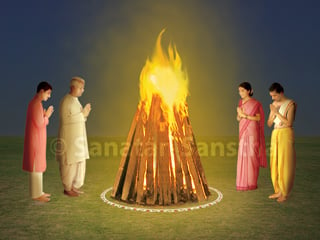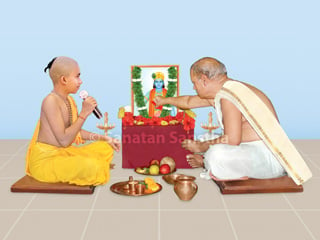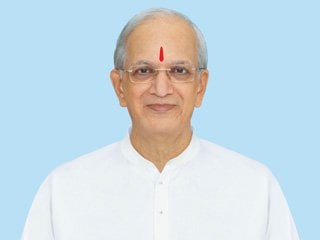Let us see the significance of the Hindu lunar month of Ashwin, which teaches us to receive the blessings of Deities through the celebration of various festivals, festivities and vowed religious observances, which makes human life prosperous and blissful
1. Important religious festivals
in the Hindu lunar month of Ashwin
Sharad Navaratra, Vijayadashami, Kojagiri Pournima, Vasubaras (Gurudwadashi), Dhanatrayodashi, Narak Chaturdashi, ritualistic worship of Indra, Kuber and Lakshmi.
1A. Navaratra of the Devi : In the Navaratra commencing from the first day of Ashwin shukla paksha since it includes Sharad rutu, this Navaratra is called Sharadiya Navaratra. Navaratra is an extremely important family tradition. During the battle between Rama and Ravan to be able to annihilate Ravan Rama worshipped Devi during Navaratri.
1B. Types of vowed observances (vrat) in Navaratra : These are the following five vowed observances.
1. From the first day (pratipada) to the ninth day (navami) : Full Navaratra vrat of nine days
2. From first day (pratipada) to the seventh day (saptami) : Seven day vrat
3. From the fifth day (panchami) to the ninth day (navami) : Five day vrat
4. Saptami to navami : Three day vrat
5. Only ashtami : One day vrat
1C. Four main parts of Navaratra : Installing the Deity, malabandhan, lighting the oil lamp, kumarika (virgin girl) pujan
1D. Benefits of kumarika pujan as per Skanda Puran
| Name | Age of the virgin girl (years) | Benefits of worshipping the virgin girl |
| – | 1 | Splendour Kumari |
| Kumari | 2 | Fulfillment of desires and Final Liberation (Moksha) |
| Trimurtini | 3 | Fulfillment of Dharma, wealth and desire |
| Kalyani | 4 | Becoming a king |
| Rohini | 5 | Acquiring knowledge Kali |
| Kali | 6 | Six supernatural powers |
| Chandika | 7 | Winning a kingdom |
| Shambhavi | 8 | Wealth |
| Durga | 9 | Ruler of the earth |
| Subhadra | 10 | – |
1 E. Importance of listening to Saptashati in Navaratra : Every word from Saptashati is fiery. In the Markandeya Puran Devi says, ‘I shall eradicate all sorrow of the one who listens to my glory. Nightmares and severe unhappiness can be overcome by reading the Saptashati is what Devi says in Devimahatmya. Special importance has been given to the saptashati during the reign of the planet Rahu. On the eight day (ashtami) in the month of Ashwin Devi is worshipped in several ways. Bhadrakali was created at midnight on ashtami. Hence this tithi (date as per Hindu lunar calendar) is called mahaashtami.
1F. Description in Devi Bhagwat about the food to be offered to Devi on every day of Navaratra
| Day of the week | Food offered to the Deity |
| 1. Sunday | Payas (khir) |
| 2. Monday | Clarified butter of cow |
| 3. Tuesday | Bananas |
| 4. Wednesday | Cottage cheese and sugar |
| 5. Thursday | Cubed sugar |
| 6. Friday | Sugar |
| 7. Saturday | Clarified butter of cow |
1G. The following Holy verses (stotras) should be read mainly during Navaratra : Mainly Durga stotra, Mahalakshmi ashtak, Kanakdhara stotra, Ramaraksha, Shrisukta, Devyaparadh stotra and Shulini Durga sumukhi stotra.
1H. The following restrictions have to be followed during Navaratra : If these norms are followed then devotion and spiritual emotion grow. They are – partaking of sattvik food, observing celibacy, not shaving the beard or cutting hair, sleeping without a mattress or bed.
1I. Importance of days as per tithi in the month of Ashwin
| Tithis in the month of Ashwin | Importance of days |
| 1.Ashwin shukla pratipada (first day) | Ghatasthapana (installing the pot) |
| 2. Ashwin shukla panchami (fifth day) | Lalita panchami |
| 3. Ashwin shukla shashti (sixth day) | Saraswati Awahan (mul nakshatra) –invocation of Saraswati |
| 4. Ashwin shukla saptami (seventh day) | Mahalakshmi pujan, ghagri funkne |
| 5. Ashwin shukla ashtami (eighth day) | Durgashtami |
| 6. Ashwin shukla navami (ninth day) | Navaratra utthapan, Gayatri devi festivities |
| 7. Ashwin shukla dashami (tenth day) | Vijayadashami (Dasra) culmination of Navaratra |
| 8. Ashwin shukla ekadashi (eleventh day) | Pashankush ekadashi |
| 9. Ashwin pournima (full moon) | Kojagiri, Valmiki jayanti (the old perform arti for the young) |
| 10. Ashwin krushna chaturthi (fourth day) | Sankashti chaturthi |
| 11. Ashwin krushna ashtami (eighth day) | Kalashtami |
| 12. Ashwin krushna ekadashi | Rama ekadashi |
| 13. Ashwin krushna dwadashi (twelth day) | Vasubaras |
| 14. Ashwin krushna trayodashi (thirteenth day) | Dhanatrayodashi |
| 15. Ashwin krushna chaturdashi (fourteenth day) | Narak chaturdashi |
| 16. Ashwin amavasya (no moon) | Lakshmipujan end of Vikram Sanvat |
2. Vijayadashami
On this day Prabhu Shriramachandra annihilated Ravan. It is a day which proves that good triumphs over evil. It is one of the three and a half auspicious days in the Hindu calendar where every moment is auspicious.
2A. Jambudripat
Bharat varsha has three seasons summer, monsoon and winter. The monsoon has just ended, the tasks in the field have almost been completed, crops are swaying in the fields this is when Dasra comes. Family traditions followed at home are completed and now the mind is restless to express its doership. Many have gone out on this day and emerged victorious. Hence this day with the foundation of victory began to be included in the three and half auspicious muhurtas (moments).
3. Kojagiri Pournima
3A. Worshipping Kuber and other
Deities on the night of Kojagiri Pournima
To acquire wealth, accumulate it and utilise it appropriately a healthy life is necessary. On the night of Kojagiri pournima for fulfilment of all these objectives Deities Lakshmi, Kuber, Indra and Chandra are worshipped. Worshipping all these Deities light a ghee lamp at the entrance to the main door of the house. On this day Shri Dattaguru gave Parshuram the gift of ‘Shri vidya’. To be able to get all kinds of splendour after worshipping the Deities the Shrisukta should be read.
4. Deepawali
Deepawali is the period from dwadashi (twelfth day) in krushna paksha of Ashwin to amawasya (no moon) and from Kartik pratipada (first day) to dwitiya (second day), in all a period of six days.
4A. Vasubaras
Diwali commences from Vasubaras. As Bharat is a predominantly agricultural country worshipping mother cow with thoughts of fields, health of man, sanskars etc is itself a kind of gratitude.
4B. Dhanatrayodashi
This comprises of three religious festivals. The jewel obtained after churning of the celestial ocean is referred to as the 14th one. On this day Dhanwantari (Deity of health) lying within it is worshipped so also Deities Lakshmi, Vishnu, Kuber, Yogini, Ganesh, Nag and wealth. A tradition of offering lamps to Yama on this day has commenced.
4C. Narak Chaturdashi
This is the day meant to celebrate happiness after annihilation of the demon Narkasur.
4D. Lakshmipujan
This is an important ritual celebrated on amavasya from the six days of Diwali. After She is worshipped She is offered fruit and food (naivedya) followed by aarti and then bliss is distributed along with the Holy sacrament (prasad).’

 Holi / Holika Dahan 2024
Holi / Holika Dahan 2024 Shrikrishna Janmashtami Pooja (along with mantras and their meaning)
Shrikrishna Janmashtami Pooja (along with mantras and their meaning) Akshay Trutiya 2023
Akshay Trutiya 2023 Tripurari Poornima (Kartik Poornima)
Tripurari Poornima (Kartik Poornima) Message from Shrichitshakti (Mrs) Anjali Mukul Gadgil and Shrisatshakti (Mrs) Binda Singbal on the occasion...
Message from Shrichitshakti (Mrs) Anjali Mukul Gadgil and Shrisatshakti (Mrs) Binda Singbal on the occasion... Paratpar Guru (Dr) Athavale’s message for Gurupurnima (2022)
Paratpar Guru (Dr) Athavale’s message for Gurupurnima (2022)